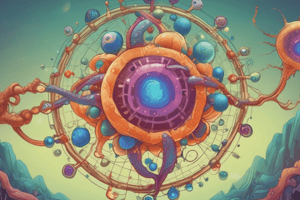Podcast
Questions and Answers
What is the main function of telomeres in chromosomes?
What is the main function of telomeres in chromosomes?
- To protect the ends of chromosomes (correct)
- To attach to the spindle fibers during cell division
- To determine the sex of an individual
- To carry genetic information in the form of DNA
How many chromosomes do human gametes (sperm and egg cells) have?
How many chromosomes do human gametes (sperm and egg cells) have?
- 22
- 23 (correct)
- 48
- 46
What is the term for the exchange of genetic material between non-homologous chromosomes?
What is the term for the exchange of genetic material between non-homologous chromosomes?
- Down syndrome
- Chromosomal deletions
- Aneuploidy
- Chromosomal translocations (correct)
What is the role of chromosomes in cell division?
What is the role of chromosomes in cell division?
What determines the sex of an individual?
What determines the sex of an individual?
What is the term for having an abnormal number of chromosomes?
What is the term for having an abnormal number of chromosomes?
Flashcards are hidden until you start studying
Study Notes
Structure of Chromosomes
- Chromosomes are thread-like structures carrying genetic information in the nucleus of eukaryotic cells.
- Each chromosome consists of:
- Centromere: the region where the chromosome attaches to the spindle fibers during cell division.
- Telomeres: the protective caps at the ends of chromosomes.
- Arms: the regions between the centromere and telomeres.
Chromosome Number
- Humans have 46 chromosomes in every cell of their body, except for gametes (sperm and egg cells) which have 23.
- The number of chromosomes varies among species, but is usually consistent within a species.
Chromosome Types
- Autosomes: non-sex chromosomes (1-22 in humans).
- Sex chromosomes: X and Y chromosomes, determining the sex of an individual.
- XX: female
- XY: male
Chromosome Functions
- Carry genetic information in the form of DNA.
- Play a crucial role in cell division, ensuring that each new cell receives a complete set of chromosomes.
- Influence the development and growth of an organism.
Chromosomal Abnormalities
- Can occur due to errors during cell division or exposure to mutagenic agents.
- Examples:
- Aneuploidy: having an abnormal number of chromosomes (e.g., Down syndrome).
- Chromosomal deletions: loss of a segment of a chromosome.
- Chromosomal translocations: exchange of genetic material between non-homologous chromosomes.
Chromosomal Mutations
- Can occur due to errors during DNA replication or exposure to mutagenic agents.
- Examples:
- Point mutations: changes in a single nucleotide.
- Frameshift mutations: changes in the reading frame of genetic code.
- Chromosomal inversions: reversal of a segment of a chromosome.
Studying That Suits You
Use AI to generate personalized quizzes and flashcards to suit your learning preferences.




